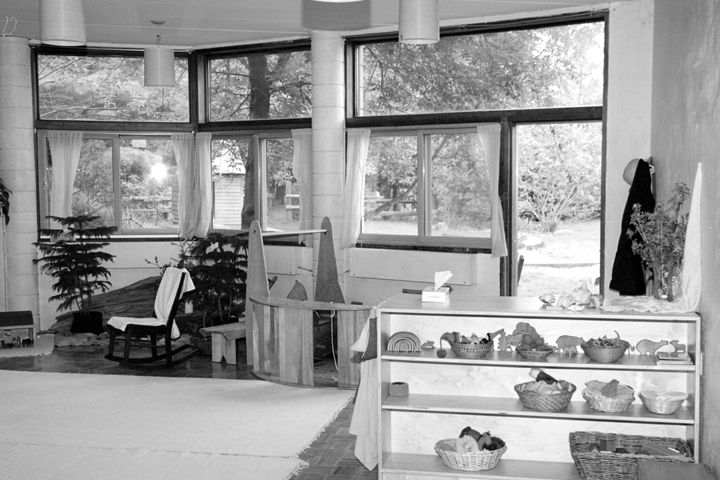Likewise, children’s experiments with color figure prominently in the Waldorf curriculum and color is itself judged to be related to children’s temperaments (Carlgren, 1976). Yet color also has a moody and spiritual quality within the Waldorf philosophy which has design implications for the hue, texture, and lighting of rooms and corridors. Ideally, argue Waldorf educators, the built and natural environments of the outdoors, home, and school will each reflect and complement, through form, color, and other characteristics, the developmental experience of childhood. In short, the physical make-up of home and school are deemed to have a subtle, but important influence on the young child’s development, her temperament, affective life, and psychic well-being.
Steiner argued that the surrounding environment permeates children’s aesthetic and spiritual lives. He projected well into middle childhood a state of being similar to that of Montessori’s own early childhood notion of the unconscious absorbent mind. Yet while Montessori concluded that this immersive period ends in late infancy, Steiner (1924) posited an extended period of environmental surrogacy which lasts until about age nine:
"The child is not in a position to distinguish clearly between himself and the outside world; even in his feeling life, the feeling of the world and the feeling of his own ego are not clearly distinguished ... he looks upon what goes on outside him as a continuation of his own being." (p. 81)
Through her subconscious, instinctive imitation of those around her and through the unconscious absorption of the environment, the child comes to know the world and further refine the basis of her identity. The child’s consciousness “extends beyond the sphere of her little body,” wrote A.C. Harwood (1958, pp. 15-16). “In an impersonal, dream-like, or rather sleep-like, way the child’s powers of consciousness are living in her environment.” To support this child ideal of place, Steiner proposed something akin to Froebel’s (1826) original vision of the kindergarten (Dudek, 2000a) as “a garden of children." The interior of a Waldorf school, with its characteristic fleshy and earth-tone wall colors and beautifully designed spaces for music, dance, and handicrafts, would be purposefully crafted to complement the organic character of a natural setting, the aesthetic needs of the child, and the artistic focus of the Waldorf curriculum:
"[In designing the Hartsbrook Waldorf School in Massachusetts] we focused on the curriculum and its appropriate enhancement through architecture and landscape. Our discussion considered such topics as the spiritual and philosophical foundations of the Waldorf education, the learning path of the child, the characteristic qualities of each class year, and how these qualities may be embodied architecturally. We also explored the vernacular architectural impulse, the land, and its history. The relationships of classroom spaces to the immediate sites and distant views were carefully considered as were the spaces themselves, in terms of form, colour, proportion, and detail." (As quoted in Sanoff, 1994, p. 103)
It is perhaps not surprising, given the organic epistemology of the Waldorf philosophy, that many Waldorf school communities favour rural locales over congested urban sites, a privilege not afforded to schools in most other educational traditions. The Hartsbrook Waldorf School, noted above, employs a farmhouse motif and takes its silo-like form from the common structures to be found in the neighbouring New England rural landscape. Studies in organic farming and seasonal festivals further reinforce the local community context. On the other side of the ocean, the Nant-Y-Cwm Steiner School in Britain is not only situated in a natural setting, but also purposefully set off from the surrounding thoroughfares. The long walk from the parking lot to the school aims to effect a transformation in children’s moods as they make their way on foot to class each morning:
"Children will have almost certainly traveled by car ... having had a kaleidoscopic experience [of sight and sound].... The effect of this synthetic experience may be to make them raucous and fractious. They have therefore about a hundred meters of woodland walk, crossing several thresholds to leave that world behind them. First a leaf archway, then a sun-dappled cliff edge above this shining, singing river ... Then an invitingly gestured, but slightly asymmetrical ... entrance. Then a blue purple-green corridor, quiet, low, twisting, darker." (Dudek and Day as quoted in Dudek, 2000b, p. 77)
Other features of the Nant-Y-Cwm Steiner School further endear it to its natural setting. Classrooms and corridors twist and turn to reveal irregularly curved and organic shapes. Walls taper out at their bases to create the impression of a school which is rooted in the earth. The roof is grass covered. Classrooms feature homemade interior lights and nooks and crannies that await children’s discovery. The building is paradoxically both innovative and homey at the same time.




